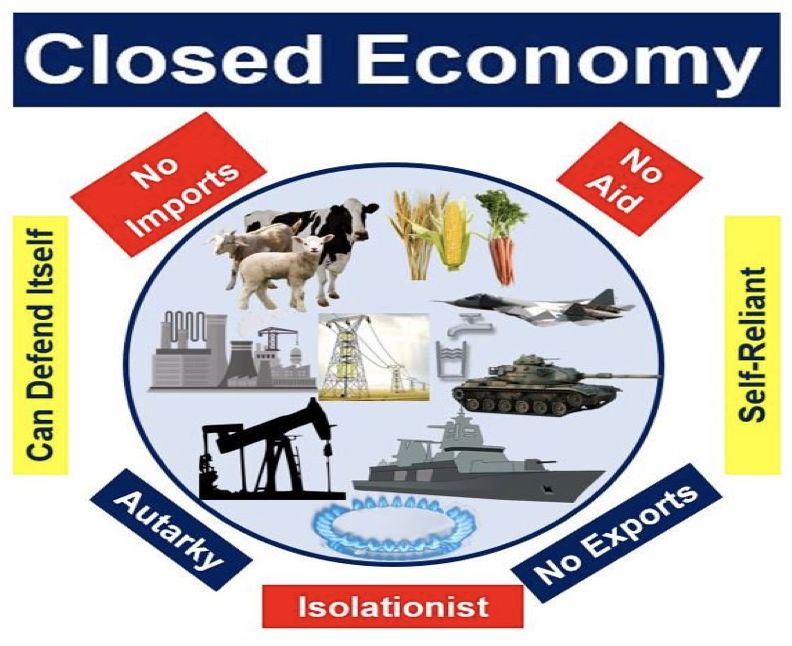What Is a Closed Economy and Why Are There None Today

What Is a Closed Economy and Why Are There None Today?
A closed economy typically refers to a country that does not trade or engage in other financial exchanges with any other country. That means no imports come into the country and no exports leave it. The goal of a closed economy is complete self-sufficiency, providing domestic consumers with everything they need from within the country’s own borders. Closed economies are more of a theoretical concept than a reality in today’s interconnected world. However, some economies are more closed than others.
Key Takeaways:
– A closed economy refers to a country that produces all of its own goods and services and doesn’t participate in international trade.
– Closed economies are virtually nonexistent today, although some countries come closer than others to having one.
– Even in countries with relatively open economies, governments may close off a specific sector or industry from international competition through the use of quotas, subsidies, and tariffs—a practice often referred to as protectionism.
Why There Are No Real Closed Economies Today:
The trend toward globalization in recent decades suggests that governments are becoming more open to participating in international trade. Closed economies are counterintuitive to modern economic theory, which promotes the opening of domestic markets to international trade to capitalize on comparative advantages. This ideally benefits all citizens by allocating labor and resources to their most productive and efficient operations.
According to the international Organisation for Economic Co-operation and Development (OECD), "Relatively open economies grow faster than relatively closed ones, and salaries and working conditions are generally better in companies that trade. More prosperity and opportunity around the world also helps promote greater stability and security for everyone."
Maintaining a genuinely closed economy is difficult in modern society because raw materials play a vital role in everyday life and the production of finished goods. Many countries that are manufacturing and exporting powerhouses do not have all the necessary raw materials locally and must import them.
For instance, in 2021, the five biggest importers of crude oil were China, the United States, India, South Korea, and Japan. The United States, in fact, both imports and exports crude oil.
A more dramatic example may be lithium, a metal that has become integral to the production of the batteries powering electric vehicles. The U.S. and many other industrialized nations have limited lithium reserves and must rely on others for their supply. Australia, Latin America, and China collectively accounted for 98% of the world’s lithium production in 2020.
Why Close Off an Economy?
Although totally closed economies are essentially nonexistent today, governments may still close off a specific industry or sector from international competition. Some oil-producing countries, for example, have prohibited foreign petroleum firms from doing business within their borders.
The argument in favor of a partially closed economy is that a completely open one runs the risk of becoming overly dependent on imports, resulting in a severely lopsided balance of trade. Also, domestic producers may suffer because they cannot compete at low international prices. Therefore, governments may use trade controls like tariffs, subsidies, and quotas to support domestic enterprises. This policy is often referred to as protectionism.
The United States, for example, which has relatively low tariffs overall, imposed a 25% tariff on steel imports and a 10% tariff on aluminum imports in 2018, in the name of protecting domestic producers from unfair foreign competition, particularly from China. In 2022, those rules were amended.
Measuring How Closed an Economy Is:
One way to assess the degree to which an economy is open or closed is by measuring the country’s imports and exports as a percentage of its gross domestic product (GDP).
By that measure, the African nation of Sudan may have the most closed economy today. Using the most recently available figures, imports represent just 1.9% of Sudan’s GDP, while exports represent 2.3%. In the U.S., by comparison, those figures are 13.3% and 10.2% respectively.
What Does Balance of Trade Mean?
The term balance of trade refers to the value of a country’s imports as compared to the value of its ports. A country that imports more than it exports will have a trade deficit, while one that exports more than it imports will have a trade surplus.
What Is the Difference Between a Tariff and a Quota?
A tariff imposes a tax on a particular good coming in from another country, while a quota limits the quantity of such goods.
What Is a Trade Subsidy?
A trade subsidy is a financial benefit that a government provides to a company or industry to make its products more competitive at home and in international markets.
The Bottom Line:
No country today appears to have a completely closed economy. But some are more closed than others. Countries with relatively closed economies rely less on imports and exports, attempting to produce whatever goods and services they require from within their own borders. Economists generally believe that relatively open economies are more beneficial for their citizens and the world at large than relatively closed ones.



